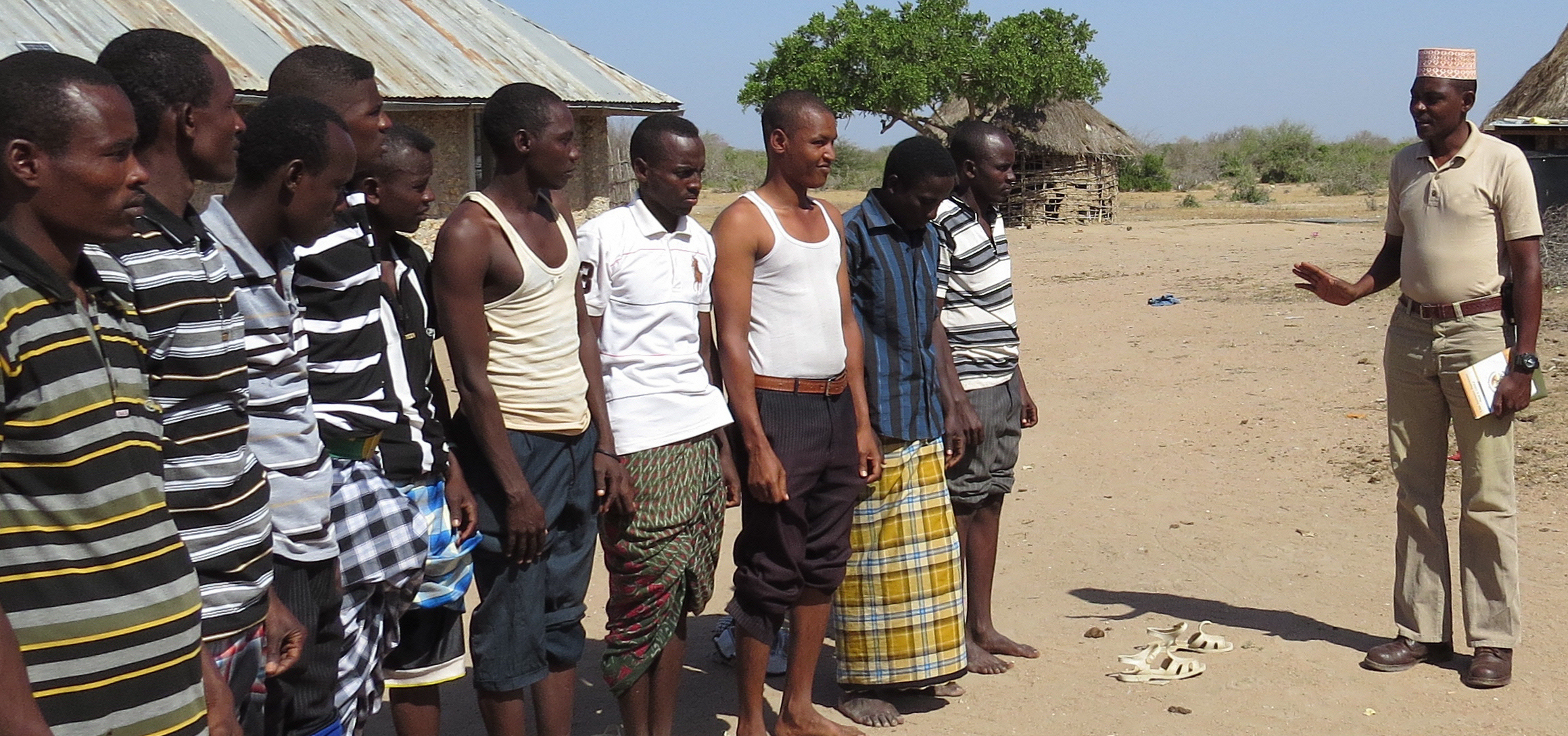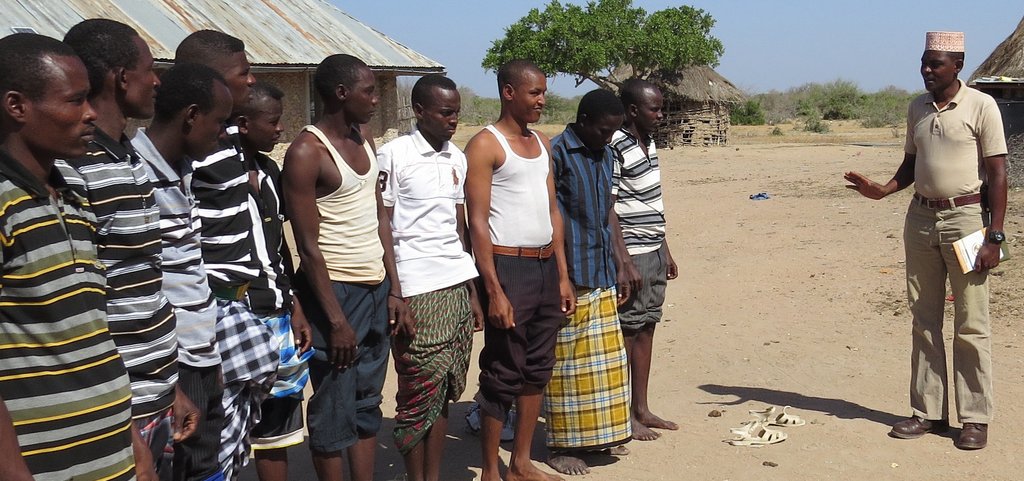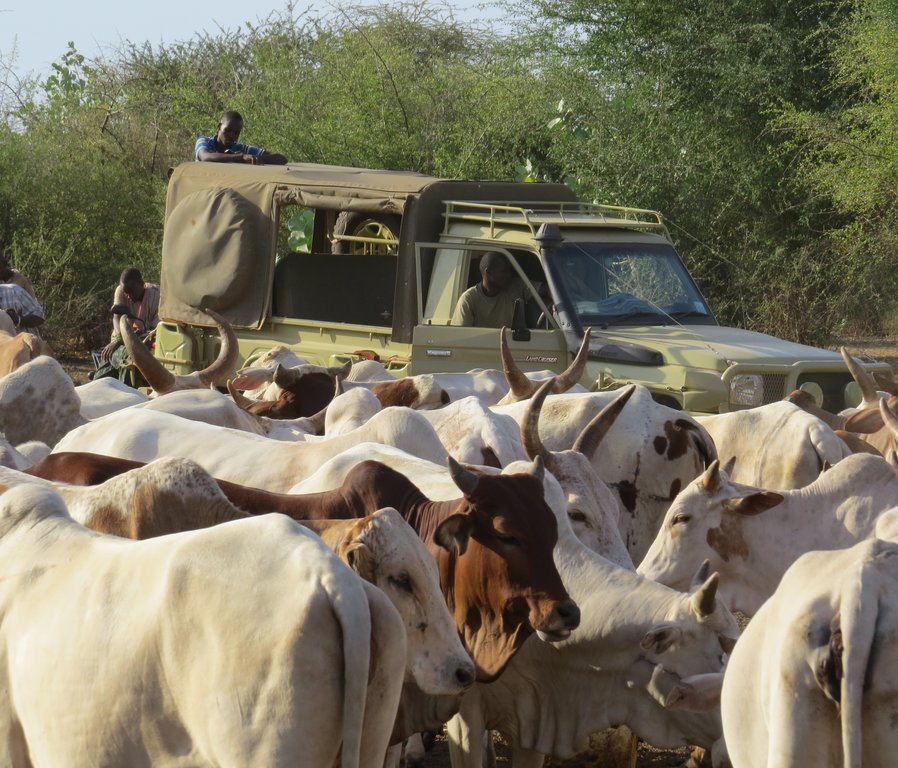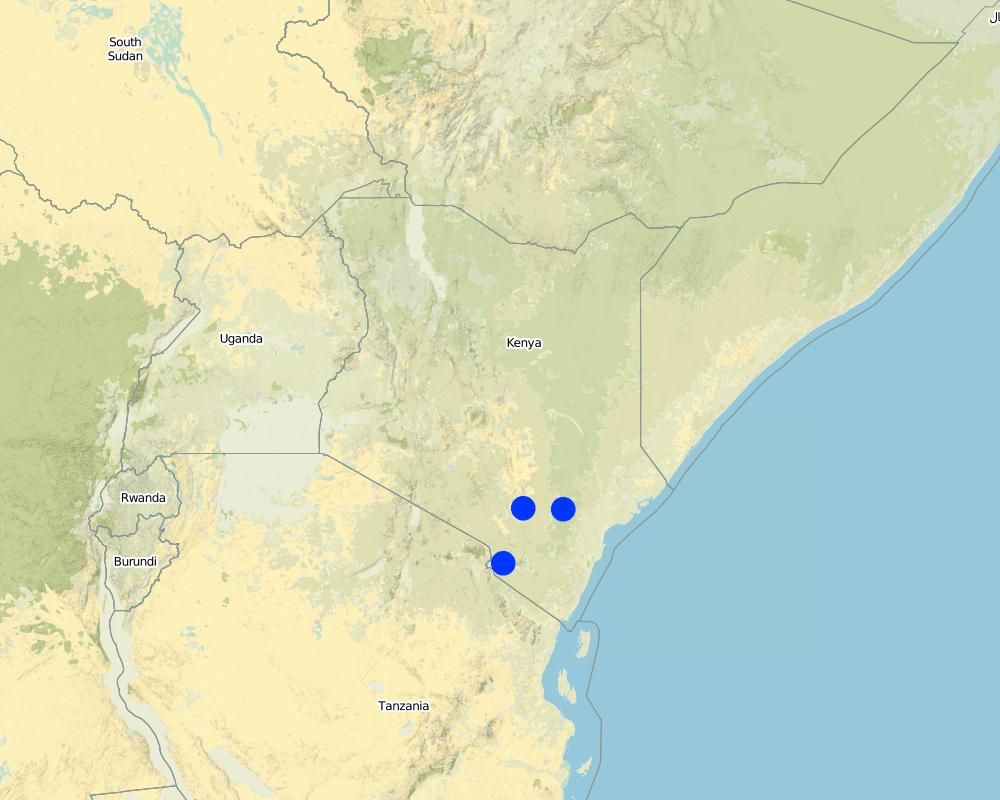Stabilization Through Conservation ('StabilCon') approach [Kenya]
- Creation:
- Update:
- Compiler: Harry Wells
- Editor: –
- Reviewers: Rima Mekdaschi Studer, Hanspeter Liniger, Donia Mühlematter
approaches_3615 - Kenya
View sections
Expand all Collapse all1. General information
1.2 Contact details of resource persons and institutions involved in the assessment and documentation of the Approach
Key resource person(s)
Protected Area Manager:
1.3 Conditions regarding the use of data documented through WOCAT
When were the data compiled (in the field)?
16/04/2018
The compiler and key resource person(s) accept the conditions regarding the use of data documented through WOCAT:
Yes
2. Description of the SLM Approach
2.1 Short description of the Approach
The 'StabilCon' approach is a non-aggressive, low-intensity stabilization model that seeks to reconcile the needs of both humans and their natural environment. To achieve this, StabilCon aims to co-develop two mutually beneficial elements: sustainable natural resource management and human security in rural areas.
2.2 Detailed description of the Approach
Detailed description of the Approach:
StabilCon is a holistic approach that seeks to develop social-ecosystems that accept wildlife and respect natural resources, in order to address complex conservation challenges. Implemented by rural communities, in partnership with local stewardship organizations, such as Tsavo Conservation Group, StabilCon aims to build human and natural resource security. StabilCon also aims to shift the human-wildlife relationship from conflict towards a symbiotic relationship with mutual benefits. The approach is based on the premise that unstable environments (whether due to human, economic or environmental factors) preclude any conservation, sustainable development or natural resource management initiative. Therefore, StabilCon seeks to build institutional capacity in rural communities to achieve four interrelated goals: 1) Support the rule of law (e.g. through training of community rangers) to reduce physical insecurity for humans, wildlife and natural resources to manageable levels as a mandatory first step; 2) Use this security as a foundation on which to build and diversify nature-based economic opportunities (e.g. reduced wildlife poaching facilitates the development of tourism-based economic opportunities, while greater local security can also benefit livestock-keeping by reducing the incidents of stock thefts); 3) Strengthen environmental security to enable benefits of biodiversity conservation and healthy ecosystems to be shared by current and future generations; 4) Develop more robust, equitable and representative community governance system, aligned with county and national government agencies and their objectives (e.g. through governance training within rural communities).
StabilCon aims to use these four interrelated goals to develop a foundation of long-term environmental security and create circumstances conducive to socio-economic progress of rural communities. Activities are conducted by the StabilCon Implementation Unit (SIU), which in the Tsavo Model is composed of 5 members: 1) CEO & co-founder of Tsavo Conservation Group (TsavoCon) - responsibilities include managing TsavoCon's strategic direction through StabilCon, developing & managing strategic relationships, working with Kenya's national and county governments and US government, international fund raising; 2) TsavoCon Chief Financial Officer - Taita Taveta born and a member of the Association of Chartered Accountants (London) who leads human resources issues and is responsible for financial operations (e.g. opening bank accounts for full time staff, introducing and managing accounting software); 3) Operations Officer - supports CEO in developing strategic relationships (e.g. liaison with Taita Conservancy elders, county government officials, NGO partners) and is a Geographic Information System analyst developing a map database (e.g. elephant poaching data); 4) Liaison Officer - responsible for engagement with Orma community members of Malkahalaku Community Conservancy as well as liaison with local and national government officials, and to manage the conservancy's rangers (he was formerly an instructor with the Kenya Wildlife Service); 5) TsavoCon Pilot - responsibilities include managing aerial observation operations, TsavoCon vehicles, communications, resupply & logistics of TsavoCon assets in the field.
2.3 Photos of the Approach
2.5 Country/ region/ locations where the Approach has been applied
Country:
Kenya
Further specification of location:
Greater Tsavo Ecosystem
Comments:
For more details see: http://www.tsavocon.org/
Map
×2.6 Dates of initiation and termination of the Approach
Indicate year of initiation:
2016
If precise year is not known, indicate approximate date when the Approach was initiated:
less than 10 years ago (recently)
2.7 Type of Approach
- recent local initiative/ innovative
2.8 Main aims/ objectives of the Approach
StabilCon seeks to build institutional capacity in rural communities to achieve four interrelated goals:
1) Effective security, law and order - Support the rule of law to reduce physical insecurity for humans, wildlife and natural resources to manageable levels as a mandatory first step to enable the other three goals;
2) Economic security - Use this security as a foundation on which to build and diversify nature-based economic opportunities (e.g. livestock and tourism);
3) Environmental security - Strengthen environmental security to enable benefits of biodiversity conservation and healthy ecosystems to be shared by current and future generations;
4) Social security - Develop more robust, equitable and representative community governance system, aligned with county and national government agencies and their objectives.
2.9 Conditions enabling or hindering implementation of the Technology/ Technologies applied under the Approach
social/ cultural/ religious norms and values
- enabling
Livestock, water and security are already top priorities for local communities and are in alignment with StabilCon's objectives.
- hindering
Rural communities, limited in their access to education, find it difficult to navigate the bureaucratic processes involved in securing funding.
availability/ access to financial resources and services
- enabling
USAID and other donors assist greatly by funding StabilCon's activities.
collaboration/ coordination of actors
- enabling
The improved relationship between the Malkahalaku community and the Kenya Wildlife Service (national government), facilitated by StabilCon's Implementation Unit (SIU), has been beneficial particularly in conflict mitigation.
- hindering
Dysfunctional relationships among local chiefs and between Malkahalau community and the Kenya Wildlife Service (KWS) were initially hindering. In addition, almost every year, heightened competition over fodder/water for livestock between pastoralists and agriculturalists and between neighbouring pastoral communities lead to conflicts, which are often violent. Previously, the dysfunctional relationship between Malkahalaku community and KWS led to confrontations and destruction of KWS infrastructure. On one occasion, KWS rangers posted in the community were chased out by community members and the KWS ranger post burnt down by community members.
legal framework (land tenure, land and water use rights)
- enabling
The official conservancy status given when the Malkahalaku Community Conservancy was established in 2015 was crucial in providing land tenure security. This stronger land tenure security has been instrumental in NRM through resolving conflicts with neighbouring communities over access to grazing/water.
policies
- enabling
The Wildlife Act has been particularly beneficial through its support of conservation activities. The Act emphasises effective public participation in the management of wildlife resources, thereby setting a basis for the strengthening of community based NRM.
land governance (decision-making, implementation and enforcement)
- hindering
Poor law enforcement in rural areas leads to social insecurity at the community level. This impacts many aspects of NRM including illegal wildlife poaching and armed conflicts between pastoralist groups over access to grazing/water.
knowledge about SLM, access to technical support
- enabling
StabilCon aims to integrate the extensive local knowledge relating to pastoralism among Oromo people. However, traditional livestock management practices are also evolving and the Oromo are moving towards reducing livestock numbers and raising livestock quality (similar to the ranching approach).
- hindering
Some previous local pastoral practices are no longer applicable to the changing environment, particularly with regard to quality and number of livestock, but practices are changing. For example, the shift from emphasis on the number of livestock owned towards smaller herd sizes and higher quality livestock.
markets (to purchase inputs, sell products) and prices
- hindering
Importing meat from neighbouring countries (e.g. Tanzania, Uganda) floods Kenya's market, leading to a poor economic environment for local livestock production. StabilCon is currently planning to improve Malkahalaku Community Conservancy's access to national beef markets that will provide more favourable prices for the community's members.
workload, availability of manpower
- hindering
StabilCon has a small team, but their dedication helps compensate for the limited man hours.
other
- hindering
Social insecurity is one of the main barriers and it is exacerbated by climatic changes. More specifically, shifts in patterns and temporal distribution of rainfall pose challenges even for highly mobile pastoralists. During drought periods, heightened competition over grazing and water intensify human conflict. These conflicts over basic resources preclude NRM activities.
3. Participation and roles of stakeholders involved
3.1 Stakeholders involved in the Approach and their roles
- local land users/ local communities
Taita Taveta Wildlife Conservancies Association and Malkahalaku Community Conservancy.
In the Taita area, Taita Taveta Wildlife Conservancies Association is the main local institutional actor, as it represents all 28 conservancies in the area (a large number of community members sign up to be part of one or more conservancies). In the Tana River County area, Malkahalaku Community Conservancy is the main institutional actor.
- SLM specialists/ agricultural advisers
Tsavo Conservation Group (TsavoCon). TsavoCon is composed of four members: CEO (an experienced protected area manager and leader of international relations; degree in Wildlife Conservation Management), Tana River County Coordinator (paramilitary-trained with experienced in wildlife conservation/anti-poaching; diploma in Wildlife Sanctuary Management), Taita Taveta County Coordinator (experienced wildlife conservationist and former CEO of Taita Taveta Wildlife Conservancies), Chief Financial Officer (experienced in conservation-focused non-profit management).
In the Tsavo Model of StabilCon, TsavoCon is the main facilitating organization, providing a link between local communities, livestock and rangeland management experts and international funding organisations. TsavoCon acts as the StabilCon Implementation Unit (SIU) in the Greater Tsavo Ecosystem.
- researchers
Geographic Information System specialist.
This researcher compiles data collected by StabilCon on poaching and insecurity. Tracking trends in elephant poaching as an indicator of increased security is one of the ways in which these data are used.
- NGO
Global Environmental Facility, African Wildlife Foundation, Wildlife Works.
These NGO's fund StabilCon's activities and/or act as conservation partners of Tsavo Conservation Group.
- local government
These include: the county environmental minister and their department; the county minister of lands; the county minister of livestock; the chairman of conservation compensation committee.
These actors are involved in allocation of local government support for community-level projects.
- national government (planners, decision-makers)
Kenya Wildlife Service (KWS), County Security Committee (national security apparatus)
These actors are mandated national security agencies. KWS's Law Enforcement Academy trained 22 members of Malkahalaku Community Conservancy (funded by Tsavo Conservation Group), who are now rangers for the conservancy. These rangers patrol their conservancy, increasing human security and reducing poaching. During droughts, KWS allow Malkahalaku Community Conservancy livestock to graze in Tsavo East National Park to relieve pressure on the community and diffuse conflicts over fodder/water. In Kenya, this is a relatively common but controversial practice as it puts pressure on the land within the protected area and potentially increases herd sizes and overall grazing pressure, particularly over the long term.
- international organization
USAID, Global Environment Facility, African Wildlife Foundation, Wildlife Works
Funding and/or Tsavo Conservation Group conservation partners.
If several stakeholders were involved, indicate lead agency:
In the Tsavo model of StabilCon, Tsavo Conservation Group fulfils the role of StabilCon Implementation Unit (SIU), and is the lead facilitator and coordinator in the Greater Tsavo Ecosystem.
3.2 Involvement of local land users/ local communities in the different phases of the Approach
| Involvement of local land users/ local communities | Specify who was involved and describe activities | |
|---|---|---|
| initiation/ motivation | interactive | Under the StabilCon approach, international and local actors are involved in the initiation phase but it leads towards self mobilization. |
| planning | interactive | The StabilCon Implementation Unit (composed of a coordinator, experts/professionals and local actors) leads the planning phase, which includes an area identification and a ground feasibility study. |
| implementation | self-mobilization | All activities are implemented by local communities. |
| monitoring/ evaluation | external support | Data is mainly collected and analyzed by specialists/experts. |
3.3 Flow chart (if available)
3.4 Decision-making on the selection of SLM Technology/ Technologies
Specify who decided on the selection of the Technology/ Technologies to be implemented:
- mainly land users, supported by SLM specialists
Explain:
StabilCon aims to bring together international SLM experience with local SLM knowledge to develop activities.
Specify on what basis decisions were made:
- evaluation of well-documented SLM knowledge (evidence-based decision-making)
- personal experience and opinions (undocumented)
4. Technical support, capacity building, and knowledge management
4.1 Capacity building/ training
Was training provided to land users/ other stakeholders?
Yes
Specify who was trained:
- land users
- local government (e.g. accounting, legal, economic)
Form of training:
- on-the-job
- courses
Subjects covered:
22 members of the Malkahalaku Community Conservancy were trained through a Kenya Wildlife Service Law Enforcement Academy programme, to enable them to serve as rangers for their conservancy to improve local security. The StabilCon implementation Unit also conducted courses to train the Conservancy's management and employees in various offices (e.g. accounting, legal, economic) to improve governance in Malkahalaku Community Conservancy.
4.2 Advisory service
Do land users have access to an advisory service?
Yes
- Depends on who is receiving the advice.
Describe/ comments:
StabilCon Implementation Unit (SIU) provides advice to individuals at multiple levels from government to local.
4.3 Institution strengthening (organizational development)
Have institutions been established or strengthened through the Approach?
- yes, greatly
Specify the level(s) at which institutions have been strengthened or established:
- local
- regional
- national
Describe institution, roles and responsibilities, members, etc.
Tsavo Conservation Group, as the StabilCon Implementation Unit (SIU), liaise with all stakeholders to develop an integrated landscape security model in Taita
Specify type of support:
- financial
- capacity building/ training
Give further details:
The Kenya Wildlife Service is due to train 40 Taita community rangers at their Law Enforcement Academy, funded by USAID in conjunction with Tsavo Conservation Group.
4.4 Monitoring and evaluation
Is monitoring and evaluation part of the Approach?
No
Comments:
The StabilCon approach relies on accurate data to inform decision making. Tsavo Conservation Group maintains a rigorous monitoring and evaluation procedure and maps human-wildlife conflict and rural human dynamics affecting the natural environment in its focal area.
4.5 Research
Was research part of the Approach?
No
5. Financing and external material support
5.1 Annual budget for the SLM component of the Approach
If precise annual budget is not known, indicate range:
- 100,000-1,000,000
Comments (e.g. main sources of funding/ major donors):
USAID and private donors are the main funding sources.
5.2 Financial/ material support provided to land users
Did land users receive financial/ material support for implementing the Technology/ Technologies?
Yes
If yes, specify type(s) of support, conditions, and provider(s):
Tsavo Conservation Group raises external funding for rangers (training, salaries etc.), security infrastructure (buildings, vehicles etc.); logistics, planning and deployment costs. However, the StabilCon approach aims to make all activities economically self-sustaining through internal funding.
5.3 Subsidies for specific inputs (including labour)
- none
If labour by land users was a substantial input, was it:
- paid in cash
Comments:
Conservancy rangers are paid in cash through StabilCon, but these costs will gradually be internalized.
5.4 Credit
Was credit provided under the Approach for SLM activities?
No
5.5 Other incentives or instruments
Were other incentives or instruments used to promote implementation of SLM Technologies?
No
6. Impact analysis and concluding statements
6.1 Impacts of the Approach
Did the Approach empower local land users, improve stakeholder participation?
- No
- Yes, little
- Yes, moderately
- Yes, greatly
The training of community conservancy rangers enables the conservancies to increase the degree to which they manage their own security, and are less dependent on already overstretched government law enforcement agencies.
Did the Approach help land users to implement and maintain SLM Technologies?
- No
- Yes, little
- Yes, moderately
- Yes, greatly
Data collected thus far indicates that elephant poaching has declined considerably since StabilCon's implementation, but it is not yet possible to gauge the sustainability due to the short duration of operation.
Did the Approach improve coordination and cost-effective implementation of SLM?
- No
- Yes, little
- Yes, moderately
- Yes, greatly
By acting as an impartial arbitrator, the StabilCon Implementation Unit facilitated coordination between chiefs who previously had dysfunctional relationships.
Did the Approach mobilize/ improve access to financial resources for SLM implementation?
- No
- Yes, little
- Yes, moderately
- Yes, greatly
StabilCon raised funding from international organizations such as USAID, that would otherwise have been inaccessible to local people.
Did the Approach improve knowledge and capacities of other stakeholders?
- No
- Yes, little
- Yes, moderately
- Yes, greatly
Capacity building was provided to local government employees (e.g. accountants, legal, economic). It was also provided to conservancy members in the form of ranger training.
Did the Approach build/ strengthen institutions, collaboration between stakeholders?
- No
- Yes, little
- Yes, moderately
- Yes, greatly
StabilCon facilitated collaboration among actors who previously did not coordinate at local-level (chiefs) and government-level (government departments).
Did the Approach mitigate conflicts?
- No
- Yes, little
- Yes, moderately
- Yes, greatly
The StabilCon Implementation Unit helped mitigate conflicts between Malkahalaku Community members and the Kenya Wildlife Service (national government) by facilitating dialogue and acting as third party mediators.
Did the Approach lead to more sustainable use/ sources of energy?
- No
- Yes, little
- Yes, moderately
- Yes, greatly
No energy source dimension to the approach.
Did the Approach improve the capacity of the land users to adapt to climate changes/ extremes and mitigate climate related disasters?
- No
- Yes, little
- Yes, moderately
- Yes, greatly
As StabilCon has only been active for 3 years this is difficult to judge.
Did the Approach lead to employment, income opportunities?
- No
- Yes, little
- Yes, moderately
- Yes, greatly
StabilCon created job opportunities relating to conservancy security (mainly rangers).
6.2 Main motivation of land users to implement SLM
- increased profit(ability), improved cost-benefit-ratio
Wealth and a better life are the main motivations for all activities.
- rules and regulations (fines)/ enforcement
Law enforcement at the community level in rural communities is one of the main benefits of formally trained conservancy rangers.
- conflict mitigation
Conflict mitigation is a significant aspect of this approach. The presence of formally trained rangers benefits community members in the form of improved social security and possibly economic opportunities (e.g. less wildlife poaching may improve tourism and fewer stock thefts may facilitate livestock-keeping).
6.3 Sustainability of Approach activities
Can the land users sustain what has been implemented through the Approach (without external support)?
- uncertain
If no or uncertain, specify and comment:
StabilCon has only been active for 3 years so this is difficult to gauge.
6.4 Strengths/ advantages of the Approach
| Strengths/ advantages/ opportunities in the land user’s view |
|---|
| Due to StabilCon's structured approach, it can be budgeted in the long term. |
| StabilCon requires minimal intervention and relies mainly on internal motivation and activity. |
| The long-term aim is for revenue to be generated internally and sustainably through a structured investment model. |
| Strengths/ advantages/ opportunities in the compiler’s or other key resource person’s view |
|---|
| Enables local communities to access international funds. |
| The StabilCon approach seeks to leverage the interaction between SLM and human security. |
| Integration of international SLM experience with local knowledge. |
| The StabilCon approach seeks to identify the extraordinary in people and nurture their strengths |
6.5 Weaknesses/ disadvantages of the Approach and ways of overcoming them
| Weaknesses/ disadvantages/ risks in the land user’s view | How can they be overcome? |
|---|---|
| The need to raise start-up funding. | Ensure adequate focus on fund-raising. |
| StabilCon is not a stand-alone 'silver bullet', but needs a certain amount of national infrastructure in place in order to operate. | None. |
| StabilCon depends heavily on the individuals employed and can thus be impacted considerably by the human weaknesses of individuals. | Over the long-term, educate people to develop interdisciplinary skills. |
| Weaknesses/ disadvantages/ risks in the compiler’s or other key resource person’s view | How can they be overcome? |
|---|---|
| With few years of active experience of StabilCon, the benefits, downfalls and sustainability of the approach are still unclear. | Continuation of the approach will reveal its strengths and weaknesses. |
7. References and links
7.1 Methods/ sources of information
- interviews with SLM specialists/ experts
One expert (co-founder & CEO of Tsavo Conservation Group and the StabilCon approach)
- compilation from reports and other existing documentation
Reports and documentation shared by the informant and project websites.
7.2 References to available publications
Title, author, year, ISBN:
Saunders I, Saunders T (2017) The StabilCon Brief
Available from where? Costs?
Freely available an in the public domain
7.3 Links to relevant information which is available online
Title/ description:
Stabilization Through Conservation (StabilCon) on Tsavo Conservation Group website
URL:
http://www.tsavocon.org/stabilcon/
Title/ description:
Tsavo Conservation Group's eMAP (Elephant Monitoring and Anti-Poaching) project
Links and modules
Expand all Collapse allLinks
No links
Modules
No modules






